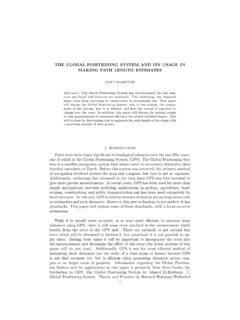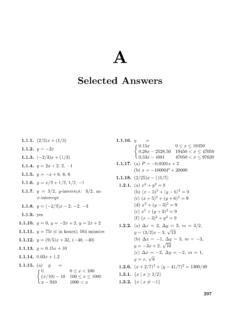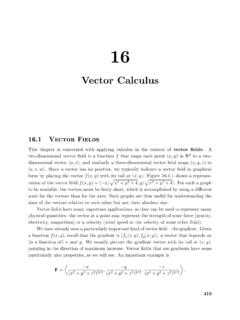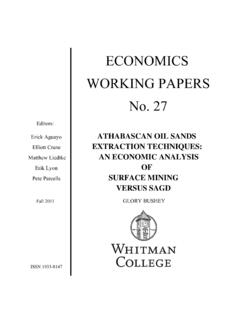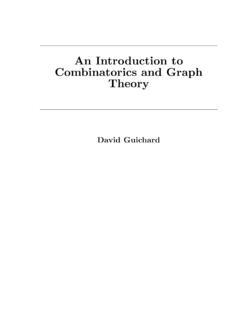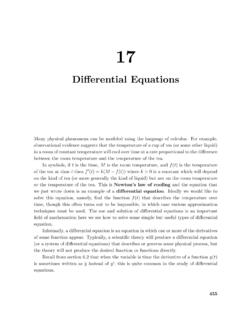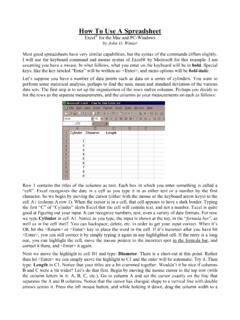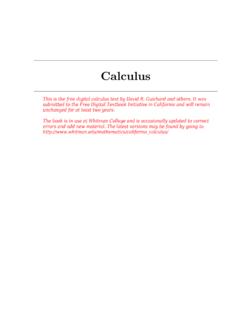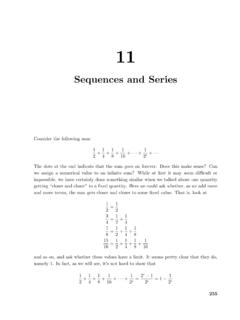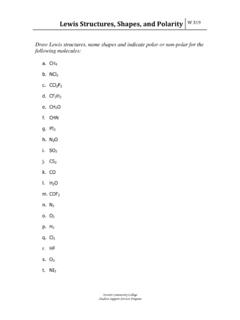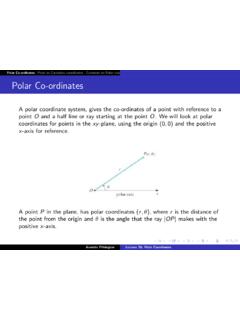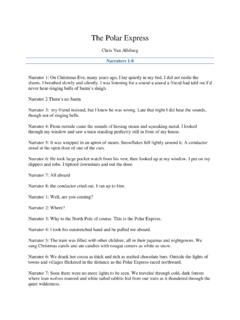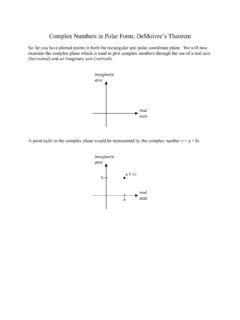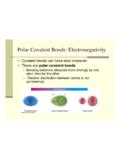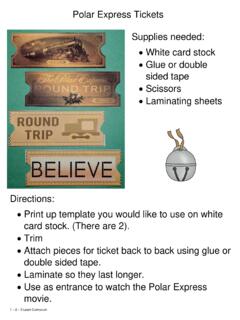Transcription of Polar Coordinates, Parametric Equations - Whitman College
1 10 Polar Coordinates, Parametric systems are tools that let us use algebraic methods to understand therectangular(also calledCartesian) coordinates that we have been using arethe most common, some problems are easier to analyze in alternate coordinate coordinate system is a scheme that allows us to identify anypoint in the plane orin three-dimensional space by a set of numbers. In rectangular coordinates these numbersare interpreted, roughly speaking, as the lengths of the sides of a rectangle. Inpolarcoordinatesa point in the plane is identified by a pair of numbers (r, ).
2 The number measures the angle between the positivex-axis and a ray that goes through the point, asshown in figure ; the numberrmeasures the distance from the origin to the shows the point with rectangular coordinates(1, 3) and Polar coordinates(2, /3), 2 units from the origin and /3 radians from the positivex-axis. (2, /3) ..Figure coordinates of the point (1, 3).237238 Chapter 10 Polar Coordinates, Parametric EquationsJust as we describe curves in the plane using Equations involvingxandy, so can wedescribe curves using Equations involvingrand.
3 Most common are Equations of the formr=f( ).EXAMPLE the curve given byr= 2. All points withr= 2 are atdistance 2 from the origin, sor= 2 describes the circle of radius 2 with center at the curve given byr= 1 + cos . We first considery=1 + cosx, as in figure As goes through the values in [0,2 ], the value ofrtracksthe value ofy, forming the cardioid shape of figure For example,when = /2,r= 1 + cos( /2) = 1, so we graph the point at distance 1 from the origin alongthepositivey-axis, which is at an angle of /2 from the positivex-axis.
4 When = 7 /4,r= 1 + cos(7 /4) = 1 + 2/2 , and the corresponding point appears in the fourthquadrant. This illustrates one of the potential benefits of using Polar coordinates: theequation for this curve in rectangular coordinates would bequite /2 3 /22 ..Figure cardioid:y= 1 + cosxon the left,r= 1 + cos on the point in the plane is associated with exactly one pair ofnumbers in the rect-angular coordinate system; each point is associated with aninfinite number of pairs inpolar coordinates. In the cardioid example, we considered only the range 0 2 ,and already there was a duplicate: (2,0) and (2,2 ) are the same point.
5 Indeed, everyvalue of outside the interval [0,2 ) duplicates a point on the curver= 1 + cos when0 <2 . We can even make sense of Polar coordinates like ( 2, /4): go to the direc-tion /4 and then move a distance 2 in the opposite direction; see figure As usual,a negative angle means an angle measured clockwise from the positivex-axis. The pointin figure also has coordinates (2,5 /4) and (2, 3 /4).The relationship between rectangular and Polar coordinates is quite easy to under-stand. The point with Polar coordinates (r, ) has rectangular coordinatesx=rcos andy=rsin ; this follows immediately from the definition of the sine andcosine func-tions.]
6 Using figure as an example, the point shown has rectangular Polar Coordinates239 2 112 2 112 /4 ..Figure point ( 2, /4) = (2,5 /4) = (2, 3 /4) in Polar ( 2) cos( /4) = 2 andy= ( 2) sin( /4) = 2. This makes it veryeasy to convert Equations from rectangular to Polar the equation of the liney= 3x+ 2 in Polar coordinates. Wemerely substitute:rsin = 3rcos + 2, orr=2sin 3 cos .EXAMPLE the equation of the circle (x 1/2)2+y2= 1/4 in polarcoordinates. Again substituting: (rcos 1/2)2+r2sin2 = 1/4. A bit of algebra turnsthis intor= cos(t).
7 You should try plotting a few (r, ) values to convince yourself thatthis makes the Polar equationr= . Here the distance from the originexactly matches the angle, so a bit of thought makes it clear that when 0 we get thespiral of Archimedes in figure When <0,ris also negative, and so the full graphis the right hand picture in the figure. (2 ,2 )( , )( /2, /2)(1,1).. ( 2 , 2 )( , )( /2, /2)( 1, 1)..Figure spiral of Archimedes and the full graph ofr= .Converting Polar Equations to rectangular Equations can besomewhat trickier, andgraphing Polar Equations directly is also not always 10 Polar Coordinates, Parametric EquationsEXAMPLE 2 sin.
8 Because the sine is periodic, we know that wewill get the entire curve for values of in [0,2 ). As runs from 0 to /2,rincreasesfrom 0 to 2. Then as continues to ,rdecreases again to 0. When runs from to2 ,ris negative, and it is not hard to see that the first part of the curve is simply tracedout again, so in fact we get the whole curve for values of in [0, ). Thus, the curve lookssomething like figure Now, this suggests that the curve could possibly be a circle,and if it is, it would have to be the circlex2+ (y 1)2= 1. Having made this guess, wecan easily check it.]]
9 First we substitute forxandyto get (rcos )2+ (rsin 1)2= 1;expanding and simplifying does indeed turn this intor= 2 sin .1 ofr= 2 sin .Exercises these Polar coordinate points on one graph: (2, /3), ( 3, /2), ( 2, /4), (1/2, ),(1,4 /3), (0,3 /2).Find an equation in Polar coordinates that has the same graph as the given equation inrectangular 3x 4 1 +y2= 5 sinx 5x+ 2 2 + 1 3x2 2x +y2 Sketch the cos sin( + /4) sec /2, 1 + / cot csc + cos 2 sec csc Slopes in Polar coordinates241In the exercises below, find an equation in rectangular coordinates that has the same graph asthe given equation in Polar sin(3 ) sin2 sec csc tan oordinatesWhen we describe a curve using Polar coordinates, it is stilla curve in thex-yplane.
10 Wewould like to be able to compute slopes and areas for these curves using Polar have seen thatx=rcos andy=rsin describe the relationship between polarand rectangular coordinates. If in turn we are interested ina curve given byr=f( ),then we can writex=f( ) cos andy=f( ) sin , describingxandyin terms of first of these Equations describes implicitly in terms ofx, so using the chain rule wemay computedydx=dyd d /dx= 1/(dx/d ), we can instead computedydx=dy/d dx/d =f( ) cos +f ( ) sin f( ) sin +f ( ) cos .EXAMPLE the points at which the curve given byr= 1 + cos has avertical or horizontal tangent line.
